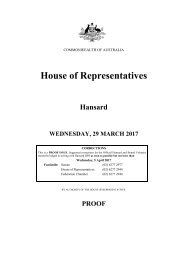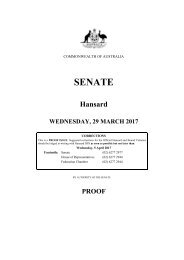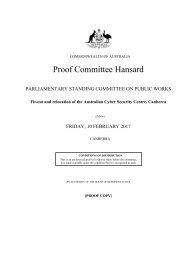SENATE
2l9k6eH
2l9k6eH
You also want an ePaper? Increase the reach of your titles
YUMPU automatically turns print PDFs into web optimized ePapers that Google loves.
Monday, 27 February 2017 Senate Page 35<br />
Mr Stefanic: There is no finalised conservation management plan or design principles. There was a project to<br />
complete those documents. The first draft of those arrived on my desk shortly after I commenced with DPS in<br />
December 2015. As part of a normal process which I instituted with the assistance of Dr Heriot, as a regular<br />
practice we consult with the moral rights holders for advice. The feedback we received on those draft documents<br />
was quite disconcerting. It would appear that in developing the brief my department had not consulted with Mr<br />
Giurgola or the moral rights holders, and consequently the documents that were prepared had some significant<br />
factual inaccuracies in them and required a substantial amount of work to repair. I wrote to the consultants<br />
seeking their advice about making changes to the documents. One of the consultants obliged and made relevant<br />
changes to the document. The consultants to the conservation management plan disagreed with a lot of the<br />
feedback and refused to make those changes. I felt that we were at an impasse and, given the resources that would<br />
be required to complete those documents, by mutual agreement I decided to terminate the contracts for both the<br />
CMP and the design principles.<br />
In its place, in July last year I engaged Ms Pamille Berg, who was the original author of the central reference<br />
document which was discontinued some years ago. I re-engaged her for the completion of that document, which<br />
was to be the single source of authority on the design intent of Parliament House. That project has now started. As<br />
we complete various chapters we intend to prepare what you might call a management plan. This will eventually<br />
become the management plan for the parliament. I am sorry, that was a really long answer to your question, but it<br />
was important for you to understand the context.<br />
Senator LUDLAM: Is that the document that will end up being tabled once it has been completed?<br />
Mr Stefanic: The current version of the central reference document is on the intranet. As the document is<br />
updated, the intranet will be updated similarly.<br />
Senator LUDLAM: That is available to staff and MPs, so it is not a secret—<br />
Mr Stefanic: No, anyone with an APH email address should be able to access it.<br />
Senator LUDLAM: When I first came to work here, we did not have guys with automatic weapons out the<br />
front of the building, we did not have the fences on the rooftop and the ministerial wing was not fortified to the<br />
extent that it is now. There were discussions for a while about a moat around the building. The security around<br />
this building only ever appears to go in one direction. Perhaps that is a reflection of the changing international<br />
security environment, but it appears that security is trumping the original design principles of this building again<br />
and again—not all at once, but incrementally. Where do we draw the line? Are we going to end up in a building<br />
surrounded by razor wire?<br />
Mr Stefanic: You quite rightly pointed out that the original brief for the construction of Parliament House was<br />
developed in the late 1970s. Those times were certainly different from now. Changes have been made<br />
progressively over time, as you have observed. Without going into detail, the changes that are proposed are<br />
intended to be scalable. It is my hope—I obviously cannot speak for the long-distant future—that we would not<br />
have to be creating more invasive measures in future. What we are putting in place now should serve us even if<br />
there were an escalation in the threat level.<br />
Senator BERNARDI: Ms Croke mentioned a merit selection process in a previous answer, and it tweaked my<br />
memory, so I went through my folder. There was a question about the recruitment and merit selection policy of<br />
2016. What were the substantive changes from the previous policy?<br />
Ms Croke: I will need to take that on notice. I have not reviewed the previous policy for some time.<br />
Senator BERNARDI: I will be more specific. In 2011-12, this committee had an inquiry into DPS—they<br />
seem to be rather regular, as you are probably aware. There were certain recommendations made about improving<br />
the merit selection process. These included, in regard to recruitment, that conflicts of interest had to be declared<br />
and managed externally to the recruitment panel and that each panel had to include an independent member—<br />
someone from outside of DPS. Are those two policies still in place for the 2016 recruitment and merit selection<br />
policy?<br />
Ms Croke: The conflict of interest arrangement is pretty much the same, so panel members are required to fill<br />
out a conflict of interest. That is required to go to the recruitment section before the interviews take place and<br />
people are required to declare any perceived or known conflict of interest. In terms of panel members, we have<br />
relaxed that a little. We can now have panel members within the department, but we generally require, or we do<br />
require, one to be outside of the division where the vacancy is.<br />
Senator BERNARDI: The information that I have—I will just get attachment B up here—in announcing this<br />
says, 'The updated policy aims to provide clearer guidance for panels and delegates conducting recruitment in<br />
DPS, including in relation to options to consider before filling a vacancy in DPS.' This one is an important one<br />
FINANCE AND PUBLIC ADMINISTRATION LEGISLATION COMMITTEE















